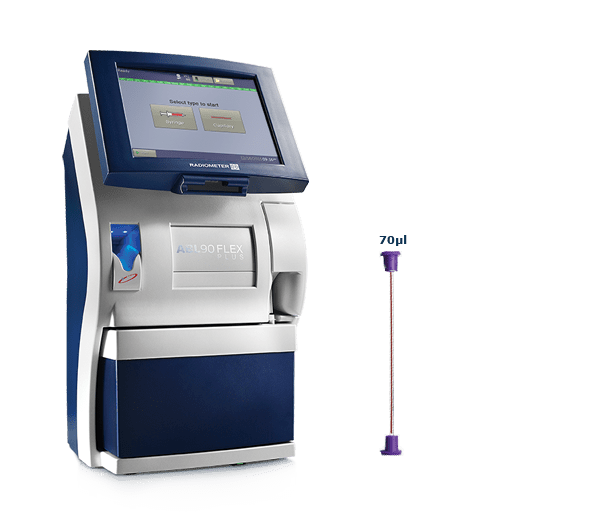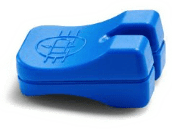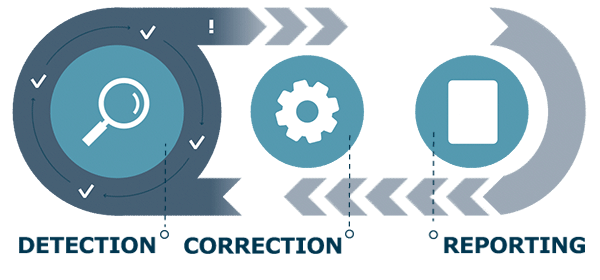
NICU point-of-care testing solution
Protecting fragile lives in the NICU - maximum insights with minimal sampling
Monitoring a neonate's status
Neonates born premature may present a range of critical conditions that caregivers need to diagnose, treat, and monitor.
The care that neonates receive in the first hours and days can have a significant impact on their quality of life. [1,2]
In the short term, the recognition and treatment of critical symptoms can save the neonate’s life. [3] In the long term, when caregivers provide correct and timely treatment and avoid life-altering complications, this helps contribute to better quality of life. [3]
Patient Blood Management
 A preterm baby born weighing just 500 grams has an estimated total blood volume of less than 50 ml.
A preterm baby born weighing just 500 grams has an estimated total blood volume of less than 50 ml.Blood sampling can deplete 30%-60% of the total neonatal blood volume in the first weeks of life.
Preterm babies endure an average of 50 painful procedures during their first four weeks of life.


Solution designed for neonatal blood gas testing
Fast, compact, and intelligent, the ABL90 FLEX PLUS blood gas analyzer delivers lab quality results on 17 critical measured parameters—including lactate, sodium, chloride, potassium, and ionized calcium—from a 65 μL sample.
Paired with Radiometer’s 70 µL safeCLINITUBES, it ensures you collect exactly what’s needed—no more, no less—with results in just 35 seconds.
Blood sampling in capillary tubes reduces the risk of anemia and circulating blood volume depletion in NICU patients.
Parameters measured with the Radiometer NICU solution
Parameters measured
Potential of hydrogen
The degree of acidity or alkalinity of any liquid (including blood) is a function of its hydrogen ion concentration [H+], and pH is simply a way of expressing hydrogen ion activity. The relationship between pH and hydrogen ion concentration is described thus:
pH = -log aH+
where aH+ is hydrogen ion activity.
Low pH is associated with acidosis and high pH with alkalosis [1].
1. CLSI. Blood gas and pH analysis and related measurements; Approved Guidelines. CLSI document CA46-A2, 29, 8. Clinical and Laboratory Standards Institute, 940 West Valley Road, Suite 1400, Wayne, Pennsylvania 19087-1898 USA, 2009.
Partial pressure of carbon dioxide
Carbon dioxide (CO2) is an acidic gas; the amount of CO2 in blood is largely controlled by the rate and depth of breathing or ventilation. pCO2 is the partial pressure of CO2 in blood. It is a measure of the pressure exerted by that small portion (~5 %) of total CO2 that remains in the gaseous state, dissolved in the blood plasma. pCO2 is the respiratory component of acid-base balance and reflects the adequacy of pulmonary ventilation. The severity of ventilator failure as well as the chronicity can be judged by the accompanying changes in acid-base status [1].
1. Higgins C. Parameters that reflect the carbon dioxide content of blood. www.acutecaretesting.org Oct 2008.
Partial pressure of oxygen
The amount of oxygen in blood is controlled by many variables, e.g. ventilation/perfusion. pO2 is the partial pressure of oxygen in a gas phase in equilibrium with the blood. pO2 only reflects a small fraction (1 – 2 %) of total oxygen in blood that is dissolved in blood plasma [1]. The remaining 98 – 99 % of oxygen present in blood is bound to the hemoglobin in the erythrocytes. pO2 primarily reflects the oxygen uptake in the lungs.
1. Wettstein R, Wilkins R. Interpretation of blood gases. In: Clinical assessment in respiratory care, 6th ed. St. Louis: Mosby, 2010.
Glucose
Glucose, the most abundant carbohydrate in human metabolism, serves as the major intracellular energy source (see lactate). Glucose is derived principally from dietary carbohydrate, but it is also produced – primarily in the liver and kidneys – via the anabolic process of gluconeogenesis, and from the breakdown of glycogen (glycogenolysis). This endogenously produced glucose helps keep blood glucose concentration within normal limits, when dietary-derived glucose is not available, e.g. between meals or during periods of starvation.
Lactate
Lactate, the anion that results from dissociation of lactic acid, is an intracellular metabolite of glucose. It is produced by skeletal muscle cells, red blood cells (erythrocytes), the brain, and other tissues during anaerobic energy production (glycolysis). Lactate is formed in the intracellular fluid from pyruvate; the reaction is catalyzed by the enzyme lactate dehydrogenase (LDH) [1].
1. Robergs RA, Ghiasvand F, Parker D. Biochemistry of exercise-induced metabolic acidosis. Am J Physiol Regul Integr Comp Physiol 2004; 287: R502-16.
Calcium
The calcium ion (Ca2+) is one of the most prevalent cations in the body, where approximately 1 % is present in the extracellular fluid of blood. Ca2+ plays a vital role for bone mineralization and many cellular processes, e.g. contractility of the heart and the skeletal musculature, neuromuscular transmission, hormone secretion and action in various enzymatic reactions such as, e.g. blood coagulation.
Chloride
Chloride (Cl-) is the major anion in the extracellular fluid and one of the most important anions in blood. The main function of Cl- is to maintain osmotic pressure, fluid balance, muscular activity, ionic neutrality in plasma, and help elucidate the cause of acid-base disturbances.
Potassium
Potassium (K+) is the major cation in the intracellular fluid, where it has a 25 - 37-fold higher concentration (∼150 mmol/L in tissue cells, ∼105 mmol/L in erythrocytes) than in the extracellular fluid (∼4 mmol/L) [1, 2]. K+ has several vital functions in the body, e.g. regulation of neuromuscular excitability, regulation of heart rhythm, regulation of intracellular and extracellular volume and acid-base status.
1. Burtis CA, Ashwood ER, Bruns DE. Tietz textbook of clinical chemistry and molecular diagnostics. 5th ed. St. Louis: Saunders Elsevier, 2012. Engquist A. Fluids/Electrolytes/Nutrition. 1st ed. Copenhagen: Munksgaard, 1985.
2. Engquist A. Fluids/Electrolytes/Nutrition. 1st ed. Copenhagen: Munksgaard, 1985.
Sodium
Sodium (Na+) is the dominant cation in the extracellular fluid, where it has a 14-fold higher concentration (∼140 mmol/L) than in the intracellular fluid (∼10 mmol/L). Na+ is a major contributor of the osmolality of the extracellular fluid and its main function is largely in controlling and regulating water balance, and maintaining blood pressure. Na+ is also important for transmitting nerve impulses and activating muscle concretion.
Carboxyhemoglobin
FMetHb is the fraction of total hemoglobin (ctHb) that is present as methemoglobin (MetHb). By convention the fraction is expressed as a percentage (%).
In the range of 0 – 60 % COHb in arterial (COHb(a)) and venous blood (COHb(v)) is similar, i.e. either venous or arterial blood may be analyzed [1]. In most medical texts FCOHb(a) is referred to as simply COHb.
1. Lopez DM, Weingarten-Arams JS, Singer LP, Conway EE Jr. Relationship between arterial, mixed venous and internal jugular carboxyhemoglobin concentrations at low, medium and high concentrations in a piglet model of carbon monoxide toxicity. Crit Care Med 2000; 28: 1998-2001.
Bilirubin
Bilirubin is the yellow breakdown product of the degradation of the heme group of hemoglobin. It is transported in blood from its site of production – the reticuloendothelial system – to the liver, where it is biotransformed before excretion in bile. Jaundice, the pathological yellow discoloration of skin, is due to abnormal accumulation of bilirubin in the tissues, and is always associated with elevated blood concentration of bilirubin (hyperbilirubinemia).
Total hemoglobin
The concentration of total hemoglobin (ctHb) in blood includes oxyhemoglobin (cO2Hb), deoxyhemoglobin (cHHb), as well as the dysfunctional hemoglobin species that are incapable of binding oxygen:
carboxyhemoglobin (cCOHb) (see COHb), methemoglobin (cMetHb) (see MetHb) and sulfhemoglobin (cSulfHb).
Thus:
ctHb = cO2Hb + cHHb + cCOHb + cMetHb + cSulfHb
The rare sulfHb is not included in the reported c tHb in most oximeters.
Fraction of fetal hemoglobin
FHbF in total hemoglobin in blood.
Fraction of deoxyhemoglobin
FHHb in total hemoglobin in blood.
Methemoglobin
FMetHb is the fraction of total hemoglobin (ctHb) that is present as methemoglobin (MetHb). By convention the fraction is expressed as a percentage (%) [1].
In most medical text boxes MetHb(a) is referred to as simply methemoglobin (MetHb).
1. CLSI. Blood gas and pH analysis and related measurements; Approved Guidelines. CLSI document CA46-A2, 29, 8. Clinical and Laboratory Standards Institute, 940 West Valley Road, Suite 1400, Wayne, Pennsylvania 19087-1898 USA, 2009.
Oxygen saturation
Oxygen saturation (sO2) is the ratio of oxyhemoglobin concentration to concentration of functional hemoglobin (i.e. oxyhemoglobin (O2Hb) and deoxyhemoglobin (HHb) capable of carrying oxygen [1].
The sO2 reflects utilization of the currently available oxygen transport capacity.
In arterial blood 98 – 99 % of oxygen is transported in erythrocytes bound to hemoglobin. The remaining 1–2 % of the oxygen transported in blood is dissolved in the blood plasma – this is the portion reported as partial pressure of oxygen (pO2) [2].
1. CLSI. Blood gas and pH analysis and related measurements; Approved Guidelines. CLSI document CA46-A2, 29, 8. Clinical and Laboratory Standards Institute, 940 West Valley Road, Suite 1400, Wayne, Pennsylvania 19087-1898 USA, 2009.
2. Higgins C. Parameters that reflect the carbon dioxide content of blood. www.acutecaretesting.org Oct 2008.
Explore the Radiometer NICU solution

Sample Size and Time to Result
17 critical care parameters:
Get lab quality results in 35 seconds with a 65uL sample size.
Bilirubin measure
Measure bilirubin to help identify and monitor the development of hyperbilirubinemia.
Automatic Quality Management (AQM)
Automatic Quality Management system facilitates reliable results.
Clot detection
Advanced clot detection system so micro and macro clots are automatically detected and removed.
70ul capillary tube made of plastic
17 parameters:
Blood gases: pH, pCO2, pO2
Metabolites: cGlu, cLac
Electrolytes: cCa2+, cCl-, cK+, cNa+
Oximetry: FCOHb, ctBil, ctHb, FHbF, FHHb, FMetHb, sO2, FO2Hb
ABL90 FLEX PLUS blood gas analyzer
Achieve comprehensive insights from less than two drops of blood.
- Comprehensive panel of parameters from a sample as small as 65 μL
- The ABL90 FLEX PLUS blood gas analyzer utilizes the AQM system for quality management and eliminates IQCP requirements
- Don't compromise on clinical value—measure 17 parameters from whole blood in just 35 seconds

Mixing wire and magnet
Designed to facilitate thorough mixing of your sample. 
Made of plastic
Eliminates the risk of breakage and sharp fragments.
Heparin
Pre-heparinized with dry electrolyte-balanced heparin, designed to minimize clots.
SafeCLINITUBES capillary tubes
Assess critically important blood gas parameters.
- Made of plastic to eliminate the risk of breakage and sharp fragments
- Contain dry electrolyte-balanced heparin to avoid heparin-induced biases and minimize the risk of clots
- The 70 μL size allows collecting exactly what’s needed—no more, no less—for 17 critical parameters
Focus on your patients while AQM automates the rest
AQM also makes it easier to review and assess your quality control data through automated activity logging and report building, which provides you with visibility into all quality metrics. This ultimately ensures you’re getting high-quality test results.
When every second counts, AQM ensures a high analyzer performance at all times so that you can focus on what is the most important—your patients.
FAQ: Neonatal care and point-of-care testing
What is a good alternative to cartridge-based testing in neonatal care?
Radiometer's neonatal solution combines the ABL90 FLEX PLUS blood gas analyzer and the safeCLINITUBES capillary tubes. The ABL90 FLEX PLUS analyzer delivers 17 critical parameters—including lactate, sodium, chloride, potassium, and ionized calcium—from just 65 µL of whole blood. Together with Radiometer’s 70 µL safeCLINITUBES, it ensures you collect exactly what’s needed—no more, no less—with results in just 35 seconds.
What benefits do you get in NICUs with sampling in capillary tubes from Radiometer?
The 70 uL safeCLINITUBES allow collection of exactly the amount of blood that is needed for gaining critical insights into 17 measured parameters. The small sample volume supports you in reducing the risk of anemia and circulating blood volume depletion.
How much blood does the ABL90 FLEX require for a neonatal test?
The ABL90 FLEX analyzer requires only 65 µL of whole blood, making it ideal for preterm and low birth weight infants and is validated for blood gas, electrolytes, metabolites and co-oximetry testing from capillary samples.
Is Radiometer’s neonatal solution available in the US?
Yes. Radiometer supports neonatal departments and NICUs across the United States.
References
2. Fanaroff AA et al. NICHD Neonatal Research Network. Trends in neonatal morbidity and mortality for very low birthweight infants. Am J Obstet Gynecol. 2007; 196, 2: 147.e
3. BOOST II United Kingdom Collaborative Group; BOOST II Australia Collaborative Group; BOOST II New Zealand Collaborative Group, Stenson BJ, Tarnow-Mordi WO. Oxygen saturation and outcomes in preterm Infants. N Engl J Med 2013; 368, 22:2094-2104.
Cookies are used on this website
Use of cookiesPlease enter a valid email
We will be sending an e-mail invitation to you shortly to sign in using Microsoft Azure AD.
It seems that your e-mail is not registered with us
Please click "Get started" in the e-mail to complete the registration process
Radiometer is using Microsoft AZURE Active Directory to authenticate users
Radiometer uses Azure AD to provide our customers and partners secure access to documents, resources, and other services on our customer portal.
If your organization is already using Azure AD you can use the same credentials to access Radiometer's customer portal.
Key benefits
- Allow the use of existing Active Directory credentials
- Single-sign on experience
- Use same credentials to access future services
Request access
You will receive an invitation to access our services via e-mail when your request has been approved.
When you accept the invitation, and your organization is already using AZURE AD, you can use the same credentials to access Radiometer's customer portal. Otherwise, a one-time password will be sent via e-mail to sign in.

